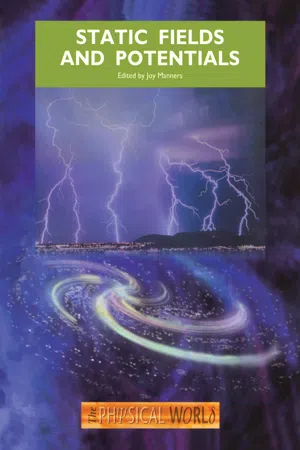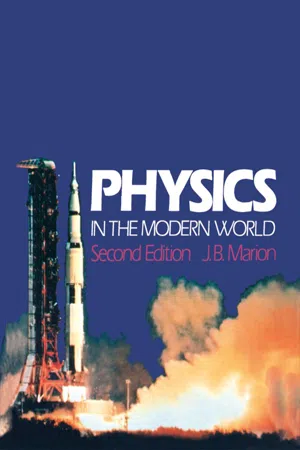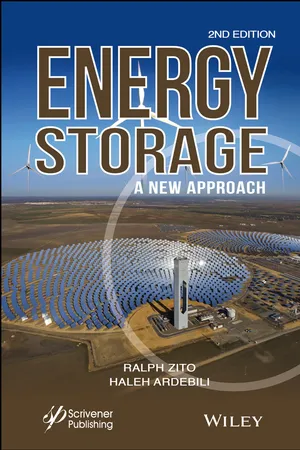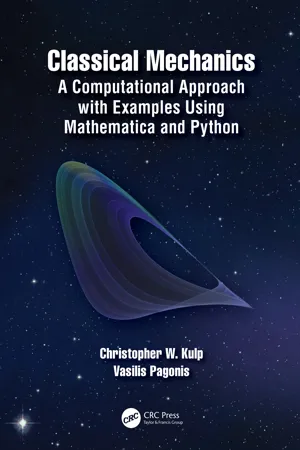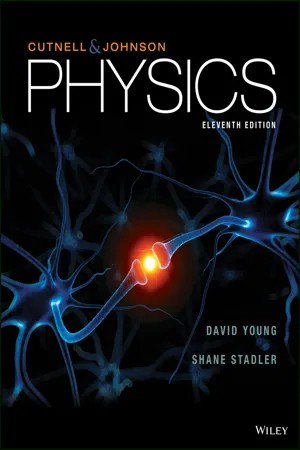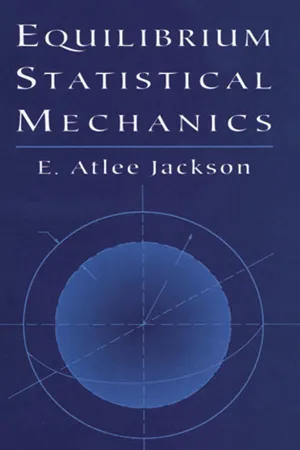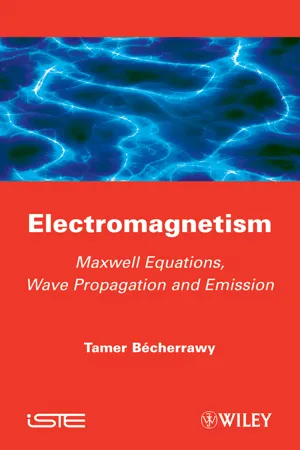Physics
Potential Energy
Potential energy is the stored energy an object has due to its position or state. It is the energy that an object possesses because of its potential to do work. The amount of potential energy an object has depends on its mass, height, and the force acting on it.
Written by Perlego with AI-assistance
Related key terms
Related key terms
1 of 4
Related key terms
1 of 3
12 Key excerpts on "Potential Energy"
- eBook - ePub
- Joy Manners(Author)
- 2020(Publication Date)
- CRC Press(Publisher)
h.A directly analogous situation, involving electrostatic Potential Energy, occurs if we move a positive charge q through a distance ∆r in a uniform electric field, ℰ and in a direction exactly opposite to the direction of that field. The work done by the conservative field will be -q−∆r and the corresponding increase in Potential Energy will be the negative of this, qq ℰq ℰ∆r. If the field is not uniform, the energy is rather more difficult to calculate (it involves an integral), but the principle is the same.Let us now consider the Potential Energy function under more general conditions. You have already met (in Chapter 2 of Predicting motion) the important relationship between a conservative force and the related Potential Energy function:(2.1a)F x= −.dE potd xFx is the component of the force F in the x-direction and dEpot /dx is the rate of change of Potential Energy with the x-coordinate: in graphical terms, dEpot /dx is the gradient of the graph of Potential Energy Epot versus position x. Similar expressions apply for the components of force in the y- and z - eBook - ePub
- Jerry Marion(Author)
- 2012(Publication Date)
- Academic Press(Publisher)
7 ENERGY Publisher Summary The total energy of a system remains the same even though energy is changed from one form to another within the system or is exchanged between objects that are part of that system. This chapter focuses on mechanical forms of energy. It discusses thermal energy, electric energy, elastic energy, and mass-energy. Work is always done when an object is moved against some resisting force. It discusses the two forms of energy: (1) kinetic energy and (2) Potential Energy. The kinetic energy of an object is proportional to its mass and to the square of its velocity. The gravitational Potential Energy that can be converted into work depends only on the change in height that the object undergoes. The chapter explains rotational kinetic energy. The importance of the energy concept was not fully understood until the middle of the 19th century. By this time it was realized that energy takes many forms—motional energy, chemical energy, heat energy, electromagnetic energy, and so forth. The great unifying principle that places all of the various forms of energy on an equal basis and makes the energy concept of truly universal significance was stated in 1847 by the German physicist Hermann von Helmholtz (1821–1894). Helmholtz’s important contribution was to realize that energy can be converted from one form to another and transferred from one object to another without loss. That is, the total energy of a system remains the same even though energy is changed from one form to another within the system or is exchanged between objects that are part of that system - eBook - ePub
Newtonian Dynamics
An Introduction
- Richard Fitzpatrick(Author)
- 2021(Publication Date)
- CRC Press(Publisher)
U represents some form of Potential Energy.The previous discussion leads to the following important conclusions. First, it should be possible to associate a Potential Energy (i.e., an energy a body possesses by virtue of its position) with any conservative force-field. Second, any force-field for which we can define a Potential Energy must necessarily be conservative. For instance, the existence of gravitational Potential Energy proves that gravitational fields are conservative. Third, the concept of Potential Energy is meaningless in a non-conservative force-field (because the Potential Energy at a given point cannot be uniquely defined). Fourth, Potential Energy is only defined to within an arbitrary additive constant. In other words, the point in space at which we set the Potential Energy to zero can be chosen at will. This implies that only differences in potential energies between different points in space have any physical significance. For instance, we have seen that the definition of gravitational Potential Energy isU = m g z, where z represents height above sea level. However, we could just as well writeU = m g ( z −, where z0 is the height of some arbitrarily chosen reference point (e.g., the top of Mount Everest, or the bottom of the Dead Sea). Fifth, the difference in Potential Energy between two points represents the net energy transferred to the associated force-field when a body moves between these two points. In other words, Potential Energy is not, strictly speaking, a property of the body; instead, it is a property of the force-field within which the body moves.z 0)5.6 Hooke’s Law
Consider a mass, m, that slides over a horizontal frictionless surface. Suppose that the mass is attached to a light horizontal spring whose other end is anchored to an immovable object. See Figure 5.8 . Let x be the extension of the spring; that is, the difference between the spring’s actual length and its unstretched length. Obviously, x can also be used as a coordinate to determine the horizontal displacement of the mass. According to Hooke’s law, the force, f - eBook - ePub
- A. L. Stanford, J. M. Tanner(Authors)
- 2014(Publication Date)
- Academic Press(Publisher)
Chapter 5 the gravitational Potential Energy function was introduced to relate the position of an object that has mass to the work done by gravitational forces on that object as it moves from one point to another. The following aspects of gravitational Potential Energy proved to be particularly important and useful:1. Differences in Potential Energy are the measurable and physically significant quantities associated with gravitational Potential Energy.2. The gravitational force is a conservative force. Equivalently, the work done on an object by the gravitational force as the object moves from one point to another (and, hence, the corresponding change in gravitational Potential Energy) is independent of the path connecting the two points.3. The gravitational Potential Energy of an object at a point is meaningful only in terms of the difference in Potential Energy between that point and the Potential Energy specified at some reference point.Electric potential should have characteristics similar to those of gravitational Potential Energy if we expect electric potential to be equally useful. In the case of electric potential, however, we will consider the charge, rather than the mass, of an object and the electrostatic coulomb force, rather than the gravitational force. We will also consider both the difference in electric potential between any two points and the specification of electric potential at a point measured relative to some reference point. First, however, we need to establish that the electric force is conservative, so that we are assured that any difference in potential between two points depends only on the positions of those points and not on the path connecting those points. We have established that the force F on a charge q at a given point is related to the electric field E at that point by F = q E , and we saw in Chapter 5 that a conservative force is one for which Similarly, showing that the electric field is conservative is equivalent to showing that - eBook - ePub
Energy Storage
A New Approach
- Ralph Zito, Haleh Ardebili(Authors)
- 2019(Publication Date)
- Wiley-Scrivener(Publisher)
The history of the development of physical concepts is not the prime concern here, but some knowledge of their evolution does serve to bring more closely to our attention and scrutiny a better appreciation of terms that we employ daily. Sometimes it is necessary to begin understanding or developing a body of knowledge in order to make certain basic assumptions on an entirely intuitive basis. As scientifically unsatisfying as that may be, it is unavoidable at times. One could draw a weak comparison to plane geometry (Euclid) with regard to its various axioms and the declaration that parallel lines never meet. Even the concept of straight lines is rather intuitive in nature.Perhaps the best definition is that a force is required to change the motion of a body. Many problems arise in finding acceptable definitions for the basic parameters of physical science, namely, the abstract concepts of mass, time, force, and energy. However, we must learn to be satisfied with definitions that leave something to be desired in order to move on toward generating a working body of mechanics that enables us to design and build practical devices that serve our purposes.An interesting definition of energy comes from the Grolier Encyclopedia, which states:Energy can be measured in terms of mechanical work, but because not all forms of energy can be converted into useful work, it is more precise to say that the energy of a system changes by an amount equal to the net work done on the system … In classical physics, energy, like work, is considered a scalar quantity; the units of energy are the same as those of work. These units may be ergs, joules, watt-hours, foot-pounds, or foot-poundals, depending on the system of units being used. In modern science, energy and the three components of linear momentum are thought of as different aspects of a single four-dimensional vector quantity, much as time is considered to be one aspect of the four-dimensional space-time continuum … Energy exists in many different forms. The form that bodies in motion possess is called kinetic energy. Energy may be stored in the form of Potential Energy, as it is in a compressed spring. Chemical systems possess internal energy, which can be converted by various devices into useful work; for example, a fuel such as gasoline can be burned in an engine to propel a vehicle. Heat energy may be absorbed or released when the internal energy of a system changes while work is done on or by the system. (1993) - eBook - ePub
- Justin P. Lomont, Ian C. Stewart(Authors)
- 2013(Publication Date)
- Visible Ink Press(Publisher)
PHYSICAL AND THEORETICAL CHEMISTRY
ENERGY IS EVERYTHING
What is physical chemistry?Physical chemistry is a branch of chemistry primarily concerned with developing a better understanding of the fundamental principles that govern chemical processes. It is an empirical science, meaning that it is based on experimental observations, though it is probably the most closely linked experimental branch of chemistry to developing new theories in chemistry. As the name implies, physical chemistry is intrinsically concerned with topics in physics that are also relevant to the study of chemistry.What is energy?In chemistry, energy serves as the “currency” for making or breaking chemical bonds and moving molecules (or matter) from one place to another.What is Potential Energy?Potential Energy describes all of the nonkinetic energy associated with an object. This energy can be the energy stored in chemical bonds, in a compressed spring, or in a variety of other ways. Another example is gravitational Potential Energy, like that associated with a ball sitting at the top of a hill. Since there are many types of Potential Energy, there isn’t a single equation that describes them all. Since the value we assign to Potential Energy is always inherently described relative to some choice of a reference value, we can only actually measure changes in Potential Energy in a meaningful way. A closed system can exchange Potential Energy for kinetic and vice versa, but the total energy must always remain constant. This is stated in the First Law of Thermodynamics, which we’ll get to soon.What is kinetic energy?Kinetic energy is the type of energy associated with the movement of an object. Faster-moving objects have more kinetic energy, and the kinetic energy of an object is related to its mass, m, and velocity, v, by the equation: - eBook - ePub
Classical Mechanics
A Computational Approach with Examples Using Mathematica and Python
- Christopher W. Kulp, Vasilis Pagonis(Authors)
- 2020(Publication Date)
- CRC Press(Publisher)
The Potential Energy function V (x) in one-dimension is defined by: F (x) = − d V (x) d x (5.1.8) Notice that (5.1.8) says that forces act so as to decrease the Potential Energy along x. Hence, in our rock-Earth example, the force of gravity is decreasing the rock’s Potential Energy and increasing the rock’s kinetic energy. Furthermore, this example illustrates that forces transfer one form of energy into another, in this case, Potential Energy transferring to kinetic. To find the Potential Energy for a given force, F(x), we need to integrate the force: V (x) − V (x 0) = − ∫ x 0 x F (x ′) d x ′ (5.1.9) For example, the gravitational Potential Energy is: V (y) − V (y 0) = − ∫ y 0 y − m g d y ′ = m g (y − y 0) (5.1.10) If we choose y 0 = 0. (and V (y 0) = 0) then we recover the familiar equation, V = mgy. Equation (5.1.9) can be rewritten as W = −Δ V and tells us that Potential Energy also measures the ability of the system to do work. By inserting (5.1.8) into (5.1.6) we get: 1 2 m v 2 − 1 2 m v 0 2 = T − T 0 = ∫ x 0 x (− d V (x ′) d x ′) d x ′ = V (x 0) − V (x) (5.1.11) or, after simplification: Conservation of Mechanical Energy T + V (x) = T 0 + V (x 0). (5.1.12) This equation is known as the conservation of mechanical energy, stating. that the sum of the kinetic and potential energies, called the total mechanical energy, is always constant if only conservative forces act on the system. Conservative forces conserve energy! Conservative forces are very useful in physics as they allow us to work with a scalar quantity, the mechanical energy E = T + V. Mechanical energy is a useful way of solving physics problems because instead of needing to keep track of the magnitude and direction of vectors, as one needs to do with forces, all one needs to do is keep track of how the value of the different types of energies are changing as the particle moves - eBook - ePub
Janice VanCleave's Physics for Every Kid
Easy Activities That Make Learning Science Fun
- Janice VanCleave, Tina Cash Walsh(Authors)
- 2021(Publication Date)
- Jossey-Bass(Publisher)
Hz), where 1 Hz = 1 cycle per second or one back and forth vibration.Potential Energy is the energy an object has because of its position relative to some zero position. It is energy that has the potential to do ‘work.’ Two types of Potential Energy investigated in this book are gravitational Potential Energy and elastic Potential Energy.- Gravitational Potential Energy is the stored energy an object has because of its position above a specific ground zero. This type of Potential Energy is due to the force of gravity acting on the object. To obtain this energy, work had to be done on an object to raise it to a higher level above ground zero, such as placing a book on a top shelf with the floor below being ground zero. Gravitational Potential Energy is directly related to the mass of the object as well as its height above ground zero. When the book is dropped from a specific height, its gravitational Potential Energy is converted to kinetic energy as the book falls.
- Elastic Potential Energy is the energy stored in an object that can be stretched or compressed. A force is needed to compress or stretch an elastic object. Consider a trampoline, which has the greatest elastic Potential Energy when it is stretched the most, as does a rubber band. A coiled spring stores elastic Potential Energy when a force compresses it as well as when a force stretches it. In both cases, when the spring is released, the spring's elastic Potential Energy results in the wound coils moving back to their normal position. Thus, the elastic Potential Energy is converted to kinetic energy.
Kinetic energy (KE) is the energy of objects that are moving. Remember, kinetic energy does not cause an object to move, instead objects have kinetic energy because they are moving. A ball at the top of a ramp has gravitational Potential Energy. As the ball rolls down the ramp, its gravitational Potential Energy is converted to kinetic energy. There are three types of kinetic energy: vibrational, rotational, and translational. Vibrational KE is the energy caused by a back and forth movement; rotational KE is the result of turning about an axis, and translational KE - eBook - ePub
- John D. Cutnell, Kenneth W. Johnson, David Young, Shane Stadler(Authors)
- 2018(Publication Date)
- Wiley(Publisher)
Problem-Solving Insight
One electron volt is the magnitude of the amount by which the Potential Energy of an electron changes when the electron moves through a potential difference of one volt.Since the magnitude of the change in Potential Energy is|q0 ΔV| = |(−1.60 × 10−19 C) × (1.00 V)| = 1.60 × 10−19 J, it follows that1 eV = 1.60 ×10J− 19One million(10+6 )electron volts of energy is referred to as one MeV, and one billion(10+9 )electron volts of energy is one GeV, where the “G” stands for the prefix “giga” (pronounced “jig′a”).In Equation 19.3 , we have seen that the electric potential is the electric Potential Energy per unit charge. In previous chapters, we have seen that the total energy of an object, which is the sum of its kinetic and potential energies, is an important concept. Its significance lies in the fact that the total energy remains the same (is conserved) during the object's motion, provided that nonconservative forces, such as friction, are either absent or do no net work. While the sum of the energies at each instant remains constant, energy may be converted from one form to another; for example, gravitational Potential Energy is converted into kinetic energy as a ball falls. We now include the electric Potential Energy EPE as part of the total energy that an object can have:=E ⏟Total energy+⏟1 2mυ 2Translational kinetic energy+⏟1 2Iω 2Rotational kinetic energy+m a g⏟Gravitationalpotential energy+⏟1 2kx 2Elasticpotential energyEPE ⏟Electricpotential energyIf the total energy is conserved as the object moves, then its final energy Ef is equal to its initial energy E0 , orEf = E0. Example 4 illustrates how the conservation of energy is applied to a charge moving in an electric field.Analyzing Multiple-Concept Problems
EXAMPLE 4 | The Conservation of Energy
A particle has a mass of1.8 × 10−5 kgand a charge of+3.0 × 10−5 C. It is released from rest at point A and accelerates until it reaches point B, as Figure 19.5 a shows. The particle moves on a horizontal straight line and does not rotate. The only forces acting on the particle are the gravitational force and an electrostatic force (neither is shown in the drawing). The electric potential at A is 25 V greater than that atB;in other words,V. What is the translational speed of the particle at point BA− VB= 25 V - eBook - ePub
Dielectrophoresis
Theory, Methodology and Biological Applications
- Ronald R. Pethig(Author)
- 2017(Publication Date)
- Wiley(Publisher)
vice versa. This is why Feynman knew he could stand stock still during his demonstration.Feynman's lecture concerned the action of the earth's gravitational field on an object having mass. An electrical force shares the same property as a gravitational force in being a reversible, conservative, force. The purpose of this chapter is to describe how the concepts of a conservative force and the work-energy theorem, widely used in the subject of mechanics, are also relevant to understanding an electrokinetic effect such as dielectrophoresis.4.2 Electrical Potential Energy
The concepts of work and Potential Energy described in Box 4.1 will now be applied to examples of the interaction of electric fields with charged bodies, commencing with the situations described in Chapter 2. In Figure 4.1 , a positively charged particle Q is located in a uniform electric field Ex . There are no components of the field acting along the y- and z-axes.Figure 4.1(a) When a positively charged particle Q moves in the direction of a uniform electric field Ex , the field does positive work on the particle and its Potential Energy U decreases. (b) If the particle moves in the opposite direction, against the field, the field does negative work and the particle's Potential Energy increases.Box 4.1 Work, Potential Energy and the Work-Energy Theorem
In the SI system the unit of work is the joule, with dimensions of newton-metre (1 J = 1 N.m). The unit of work is thus the product of the unit of force and the unit of distance. If a constant force F acts on body so that it moves a distance s in a straight line along the direction as the force, the magnitude of the work W done on the body by the force is given by:(4.1)For the general case, where the force is not constant and the body moves at an angle θ to it, the work done is calculated by summing up the product Fcosθ.ds for each incremental distance ds taken along the total displacement between points a and b - eBook - ePub
- E. Atlee Jackson(Author)
- 2012(Publication Date)
- Dover Publications(Publisher)
models (simplified pictures) of atoms, molecules, gases, and solids will illustrate the various types of interactions between particles. Finally, we shall consider some of the important modifications of these classical models that are required by quantum mechanics.2. KINETIC AND Potential Energy
To begin with, let us consider a particle moving in space as it is described in classical mechanics. The position of the particle r (t ) = x (t )i + y (t )j + z (t )k [where (i, j, k ) are the unit vectors in the (x , y , z ) directions] generally varies in time and has a velocityIf the particle has a mass m, it is said to have a kinetic energy (sometimes called the translational energy )(1)If a force F acts on the particle, its velocity will change according to Newton’s law(2)If no force acts on the particle, then it follows from Equation (2) that v is independent of the time, and consequently the kinetic energy is also a constant. We can also see this from the fact that(3)which vanishes if F vanishes.Now the force that acts on the particle generally depends on the position of the particle r and sometimes also on the velocity (e.g., frictional forces, or the force on a charged particle moving in a magnetic field). If the force depends only on r and if it can be expressed in terms of the gradient of some function Φ - eBook - ePub
Electromagnetism
Maxwell Equations, Wave Propagation and Emission
- Tamer Becherrawy(Author)
- 2013(Publication Date)
- Wiley-ISTE(Publisher)
. The dissipation of energy and its propagation are important in theoretical physics and in the applications of physics.If two systems interact (two atoms within a molecule for instance), the total interaction energy may be split into internal interaction energies UE,1 and UE,2 (between the pairs of each systems considered separately) and the interaction energy UE,(1,2) of the particles of one system with the particles of the other:[2.70]Adding the kinetic energies and the other forms of energy for each system, the total energy may be written as:[2.71]The interaction energy UE,(1,2) may be expressed in terms of the potential V1 or V2 produced by the particles of one of the systems at the positions of the charges of the other system[2.72 ]where the summations are carried over the charges of one of the systems. The knowledge of the interaction energy UE(1,2) allows the force exerted by one system on the other to be determined. For instance, if system (2) is rigid and its position is specified by a coordinate x, the x component of the force acting on it is Similarly, if its orientation is specified by an angle θ about the axis Oz, the moment of the electric forces has a component about Oz.If system (2) consists of a single particle of charge q and position r, its interaction energy with system (1) is, according to [2.72 ], where V1
Index pages curate the most relevant extracts from our library of academic textbooks. They’ve been created using an in-house natural language model (NLM), each adding context and meaning to key research topics.
Explore more topic indexes
Explore more topic indexes
1 of 6
Explore more topic indexes
1 of 4
